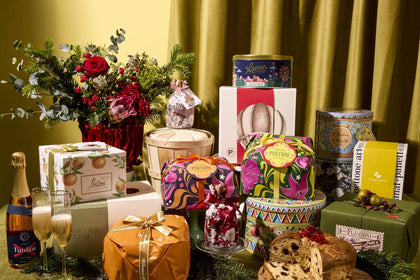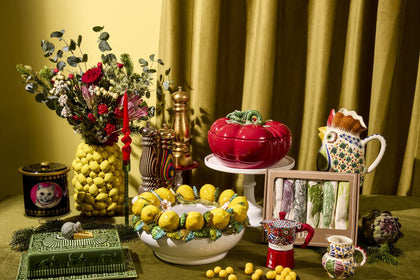What is an Enamel Pan?
by Holly Thomson

Enamel pans are made by fusing glass particles to metal. This creates a durable, glossy surface that is easy to clean.
Enamel pans can be made from cast iron or stainless steel, providing excellent heat distribution. These pans are non-reactive, meaning they won’t interact with acidic foods like tomatoes or vinegar.
Different types of enamel cookware:
- Cast iron enamel, such a Le Creuset cookware
- Stainless steel enamel, such as Kapka enamel
Popular types include Dutch ovens and baking dishes. The enamel coating prevents rust and doesn't need seasoning like pure cast iron. This makes enamel pans ideal for both cooking and serving. They come in various vibrant colours, adding aesthetic appeal to kitchens.
Cooks love enamel pans for their versatility. You can use them on stovetops or in ovens. They are also great for storing and reheating food.
Stainless steel coated enamel cookware is a popular choice for outdoor cooking and camping.
Shop all Kapka x Sous Chef enamel cookware here or read our guide What to cook in enamel cookware
Browse all pots & pans at Sous Chef, and use our guides to find the perfect cookware for your kitchen.
What are enamel pans good for?
- Frying and sauteing
- Slow-cooking and baking
- Outdoor cooking and eating
Enamel pans are great for many cooking tasks. Their smooth, non-stick surface makes them ideal for frying and sautéing. The coating ensures easy food release and simple cleanup. These pans handle acidic dishes well, so you can cook tomato sauces or lemon-based recipes without worry.
Enamel pans are also perfect for slow-cooking and baking. They maintain consistent heat, which helps in preparing stews and casseroles. Their attractive design lets them go from stove to table, serving as stylish serving pieces.
For bakers, enamel pans work well for breads and desserts. Their heat retention qualities provide even baking results. Many choose these pans for roasting meats and vegetables, appreciating the crisp, browned outcomes.
Overall, enamel pans are versatile tools for daily meals and special occasions alike. They perform well across cooking methods, making them a favourite in kitchens.
Why use enamel on cookware?
- Hard, durable surface
- Non-corroding surface
- Easy to clean
- Often colourful and attractive
Enamel coating on cookware offers several practical benefits. It provides a hard, durable surface that resists scratches and damage. This coating also makes the cookware easy to clean, as food doesn’t stick to the surface.
Using enamel-coated cookware ensures that the metal underneath does not rust or corrode. This increases the lifespan of your pots and pans. The non-reactive nature of enamel is perfect for cooking acidic foods, which might otherwise react with bare metal.
The heat distribution with enamel cookware is even and efficient, ideal for cooking techniques that require steady temperatures. Examples include simmering soups and searing meats. Enamel works on all heat sources, including induction, making it highly versatile.
Aesthetically, enamel cookware comes in a range of colours and designs. This allows them to double as serving dishes, adding a splash of colour to any dining table. Popular brands like Le Creuset have made their enamel cookware iconic for both function and style.
Are enamel pans better?
It depends on what you're cooking. Enamel pans are excellent for dishes requiring steady, even heat. Think stews or slow-cooked sauces.
Their non-reactive surface means you can cook acidic foods like tomato sauce without worry. The enamel also provides a robust, easy-to-clean surface that’s perfect for everyday meals.
However, for high-heat cooking, such as searing meat, other materials might perform better. Stainless steel, for example, excels in creating a perfect sear due to its ability to handle higher temperatures.
Enamel pans are safe, releasing no harmful chemicals into food, unlike some non-stick coatings. They are suitable for any heat source, including induction hobs, making them versatile. Their attractive appearance also allows them to double as serving dishes.
So, while enamel pans have many advantages, whether they are "better" really depends on your specific cooking needs and preferences. For certain recipes and cooking styles, they are unmatched in convenience and performance.
Is enamel the same as ceramic?
Enamel and ceramic are distinct materials used in cookware but serve different functions.
- Enamel: often made from powdered glass.
- Ceramic: crafted from clay fired at high temperatures.
Enamel is usually a type of glass that is fused to metal, usually steel or cast iron, under high heat. This process coats the metal to prevent rust and create a non-reactive surface. Examples include the outer coating on Dutch ovens and some frying pans.
Ceramic cookware, on the other hand, is made entirely from clay that's treated and hardened. It provides a naturally non-stick cooking surface without the use of metal. Ceramic pots and pans are often chosen for their effective heat distribution and retention.
However some enamel is made with vitreo-ceramic. Such as this enamel paella pan.
While both materials are popular for their durability and heat handling, they come from different compositions.
Enamel provides a hard, protective layer over metal, enhancing the metal's properties. Ceramic offers a pure construction that excels in gentle, even cooking. Each has unique aesthetic qualities as well, with enamel often featuring bright, glossy finishes and ceramic displaying a rustic, earthy look.
Is enamel better than non-stick?
It depends on your cooking style. Enamel is naturally fairly non-stick, especially if it’s heated to the right temperature and you use the right oil with a high smoke point. Enamel cast iron and enamel steel can well last longer than other non-stick pans with coatings.
Which is better, enamel or stainless steel?
It depends on your needs in the kitchen. Stainless steel is valued for its versatility and excellent heat conductivity, making it suitable for frying and sautéing. It's a favourite for searing meats and sautéing vegetables.
Enamel, on the other hand, is great for long cooking processes. Enamel cast iron maintains heat well and is often used for dishes that benefit from slow cooking, like casseroles. Enamel stainless steel is lightweight and versatile, and often a very useful addition to the kitchen shelf.
Can you put enamel pots in the oven?
Yes, you can generally use enamel pots in the oven. These pots are designed to handle high temperatures, making them suitable for baking or roasting
Always check the manufacturer's specifications to confirm the maximum temperature your enamel cookware can withstand. This will ensure optimal performance and longevity of your pots.
Can enamel go in the microwave?
No, enamel cookware should not be used in a microwave. Enamel is made from a type of glass bonded to a metal base, usually cast iron or steel. Like all metal cookware, it cannot go in the microwave.
What happens when you heat enamel?
When heated, enamel cookware evenly distributes heat across the surface, enhancing the cooking process. This heat distribution is ideal for cooking dishes that require steady, sustained heat, like soups or sauces.
The smooth, hard finish of enamel also makes it non-reactive, so it won’t interact with acidic ingredients, allowing flavours to remain pure and unaltered.
Browse all pots & pans at Sous Chef, and use our guides to find the perfect cookware for your kitchen.



